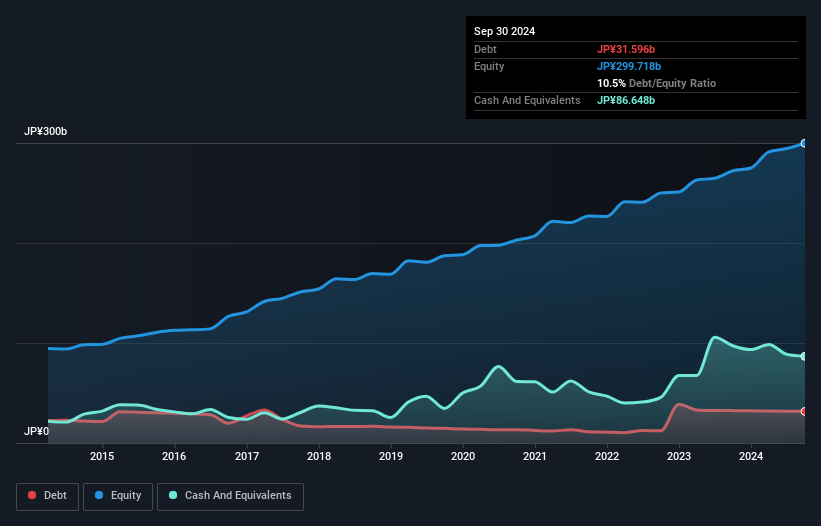Some say volatility, rather than debt, is the best way to think about risk as an investor, but Warren Buffett famously said that 'Volatility is far from synonymous with risk.' It's only natural to consider a company's balance sheet when you examine how risky it is, since debt is often involved when a business collapses. Importantly, Kyudenko Corporation (TSE:1959) does carry debt. But the more important question is: how much risk is that debt creating?
What Risk Does Debt Bring?
Generally speaking, debt only becomes a real problem when a company can't easily pay it off, either by raising capital or with its own cash flow. In the worst case scenario, a company can go bankrupt if it cannot pay its creditors. While that is not too common, we often do see indebted companies permanently diluting shareholders because lenders force them to raise capital at a distressed price. Having said that, the most common situation is where a company manages its debt reasonably well - and to its own advantage. When we think about a company's use of debt, we first look at cash and debt together.
Check out our latest analysis for Kyudenko
What Is Kyudenko's Net Debt?
As you can see below, Kyudenko had JP¥31.6b of debt, at September 2024, which is about the same as the year before. You can click the chart for greater detail. But it also has JP¥86.6b in cash to offset that, meaning it has JP¥55.1b net cash.

A Look At Kyudenko's Liabilities
According to the last reported balance sheet, Kyudenko had liabilities of JP¥149.5b due within 12 months, and liabilities of JP¥16.0b due beyond 12 months. On the other hand, it had cash of JP¥86.6b and JP¥126.2b worth of receivables due within a year. So it actually has JP¥47.3b more liquid assets than total liabilities.
This short term liquidity is a sign that Kyudenko could probably pay off its debt with ease, as its balance sheet is far from stretched. Succinctly put, Kyudenko boasts net cash, so it's fair to say it does not have a heavy debt load!
And we also note warmly that Kyudenko grew its EBIT by 20% last year, making its debt load easier to handle. There's no doubt that we learn most about debt from the balance sheet. But it is future earnings, more than anything, that will determine Kyudenko's ability to maintain a healthy balance sheet going forward. So if you want to see what the professionals think, you might find this free report on analyst profit forecasts to be interesting.
But our final consideration is also important, because a company cannot pay debt with paper profits; it needs cold hard cash. While Kyudenko has net cash on its balance sheet, it's still worth taking a look at its ability to convert earnings before interest and tax (EBIT) to free cash flow, to help us understand how quickly it is building (or eroding) that cash balance. Looking at the most recent three years, Kyudenko recorded free cash flow of 44% of its EBIT, which is weaker than we'd expect. That's not great, when it comes to paying down debt.
Summing Up
While we empathize with investors who find debt concerning, you should keep in mind that Kyudenko has net cash of JP¥55.1b, as well as more liquid assets than liabilities. And we liked the look of last year's 20% year-on-year EBIT growth. So is Kyudenko's debt a risk? It doesn't seem so to us. There's no doubt that we learn most about debt from the balance sheet. But ultimately, every company can contain risks that exist outside of the balance sheet. For example - Kyudenko has 1 warning sign we think you should be aware of.
When all is said and done, sometimes its easier to focus on companies that don't even need debt. Readers can access a list of growth stocks with zero net debt 100% free, right now.
Valuation is complex, but we're here to simplify it.
Discover if Kraftia might be undervalued or overvalued with our detailed analysis, featuring fair value estimates, potential risks, dividends, insider trades, and its financial condition.
Access Free AnalysisHave feedback on this article? Concerned about the content? Get in touch with us directly. Alternatively, email editorial-team (at) simplywallst.com.
This article by Simply Wall St is general in nature. We provide commentary based on historical data and analyst forecasts only using an unbiased methodology and our articles are not intended to be financial advice. It does not constitute a recommendation to buy or sell any stock, and does not take account of your objectives, or your financial situation. We aim to bring you long-term focused analysis driven by fundamental data. Note that our analysis may not factor in the latest price-sensitive company announcements or qualitative material. Simply Wall St has no position in any stocks mentioned.
About TSE:1959
Kraftia
Engages in design, construction, and installation of power infrastructure construction business in Japan.
Flawless balance sheet average dividend payer.
Market Insights
Community Narratives




